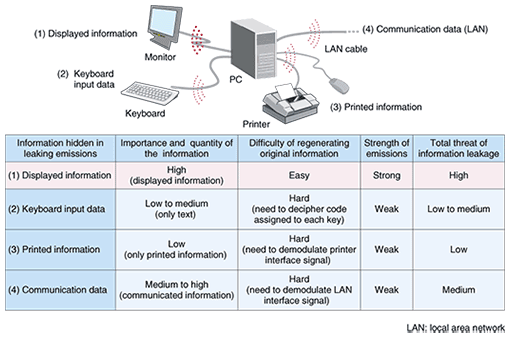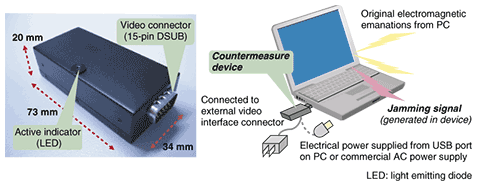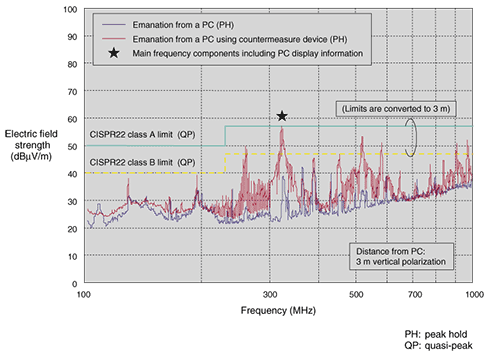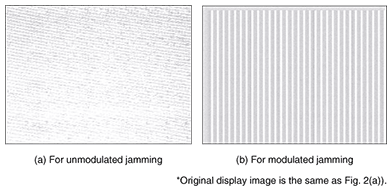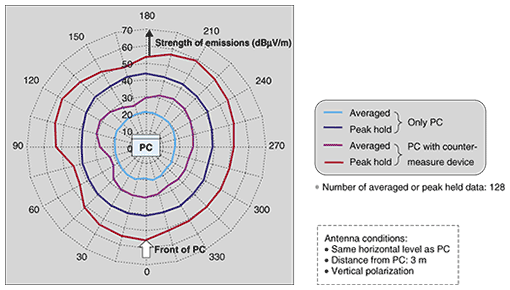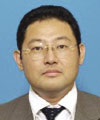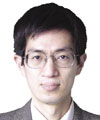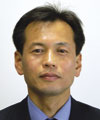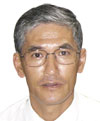 |
|||||||||||
|
|
|||||||||||
|
Special Feature: Countermeasure Technologies Against Information Leakage via Electromagnetic Emanations Vol. 6, No. 10, pp. 6–12, Oct. 2008. https://doi.org/10.53829/ntr200810sf2 Countermeasures to Prevent Eavesdropping on Unintentional Emanations from Personal ComputersAbstractThis article outlines the scheme that we have developed as a countermeasure to prevent information leakage through eavesdropping on emanations emitted by personal computers (PCs). It also describes the present performance of our current prototype. A working PC usually produces unintentional electromagnetic fields, and some of these emissions often carry significant information about what is being processed in the PC. In some cases, the content being shown on the screen of a video display unit could be reconstructed by intercepting such emissions at a distance.
1. BackgroundElectronic equipment, such as communication equipment or personal computers (PCs), usually emits unintentional radiated electromagnetic fields when it is working and these affect other equipment nearby. Conversely, the performance of such equipment is often degraded by emissions present around it. These phenomena also enable malicious persons to conduct many kinds of attacks on information security, such as eavesdropping on information leaked by these emanations or harming hardware by irradiating it with powerful fields in order to cause malfunctions or physical damage. These problems caused by electromagnetic waves are referred to as electromagnetic security problems. With the recent rapid progress of electronic technologies, the speed of signals being processed in electronic circuits has increased, and the maximum frequency of the emanations from these circuits has correspondingly increased. These emitted electromagnetic waves often carry significant information about the data being processed inside the equipment. In some cases, this hidden information can be reconstructed by intercepting such emissions, as a result of improvements in radio receiver performance and advances in signal processing techniques. Consequently, this topic represents a potential new information security threat [1], [2]. 2. TEMPEST—Eavesdropping on PC display informationInformation on a PC screen can be remotely reconstructed exactly as it appeared on the display by monitoring and appropriately demodulating the weak emanations generated by the PC and its peripheral equipment [1]. Such an eavesdropping technique had been researched by some military organizations since around 1960, but most of the results were classified and not disclosed to the public. It came to public attention in 1985 when Wim van Eck pointed out that information on a cathode ray tube display can easily be reconstructed [2]. Since his work, research on information leakage of this kind has been conducted by many organizations. The National Security Agency (NSA) in the USA refers to this type of threat by the covername TEMPEST, and this term is now in general use [3]. 2.1 Threat and features of TEMPESTSeveral kinds of security problems are caused by electromagnetic radiation (Fig. 1). For example, it has reported that the key hit by an operator on a keyboard could be deciphered, and, as another example, a printed image could reconstructed by receiving emanations leaking from a laser printer. However, the field strengths of these emanations are weaker than those of the display signals, so it is difficult to decode the original signals from these emanations.
On the other hand, eavesdropping on emitted video signals seems to pose a greater risk than the other electromagnetic security problems. This is because the information that appears on PC displays or other displays like automatic teller machine panels needs a high level of security in general, and there is much more of this information than of other types of information like text data and sound. Moreover, eavesdropping on leaking video signals can be done using simple and inexpensive equipment sold on the market if eavesdroppers have accurate knowledge about the eavesdropping technique. Electromagnetic eavesdropping on unintentional emanations has some unique features. First, the information leakage is not discovered unless an eavesdropper is caught red-handed because it leaves no trace at all. Second, information can be stolen from PCs even when they are not performing data communications, such as using a wireless local area network. 2.2 TEMPEST countermeasure schemesThere are some conventional countermeasure schemes that can protect information from TEMPEST eavesdropping. (1) Shielding Shielding devices and/or rooms with metallic materials is a reliable way to reduce the leakage of emissions. However, it is difficult and expensive to achieve complete shielding, especially for the shielding of rooms and buildings. (2) Soft tempest (using special fonts) Soft tempest is a software-based countermeasure. It has been reported that the strength of emissions can be reduced by using specifically designed fonts, which make reconstructed text images hard to read [4]. This scheme is cost effective, but the fonts are sometimes insufficiently indistinct, and it has no effect on figures or drawings. (3) Filtering Inserting filters into communication interface cables or power supply cables to suppress emissions is also effective. However, these filters need to be inserted into all of the external interfaces and tuned to the emission frequency. Moreover, this method is effective only if the emissions are radiating mainly from the interface lines rather than from the PC itself. (4) Jamming Overlaying jamming electromagnetic fields that are stronger than leaking emanations is another effective countermeasure. This enables countermeasures to be taken using simple low-cost equipment and it is applicable for mobile use. However, the jamming signals should be chosen very carefully because the effectiveness of blocking eavesdropping depends strongly on the modulation pattern of the jamming signal. We have developed a countermeasure device that uses the jamming technique to prevent the leakage of display information through unintentional emanations from PC displays. Below, we introduce the principle and functions of this device and describe how we verified its performance and applicability through experiments. 2.3 Video display interfaces for PCsAt present, the most popular video signal interfaces used for PC displays are ones standardized by VESA (Video Electronics Standards Association). The main analog-video interfaces—SVGA, XGA, and SXGA—are conventional analog raster scan video interfaces, and the video screen is constructed with pixels (minimum unit of drawing) drawn on the screen as the scanning line advances. Those video interfaces consist of three video signals corresponding to the colors red, green, and blue (RGB) and two synchronization signals: horizontal synchronization (H-sync) and vertical synchronization (V-sync). The basic time period for drawing a pixel on the video monitor is called the dot clock or pixel clock. The video signals are generated by modulating the amplitude of the dot clock pulse by the luminosity of the pixel. For example, the bit-rate of the dot clock is 65 Mbit/s for one case of XGA: when the number of pixels is 1024 × 768, H-sync frequency is 48.4 kHz, and V-sync frequency is 60 Hz. 2.4 TEMPEST eavesdropping on PC video displayThe frequency spectrum of the emanations from a PC is widely spread and their intensity is very weak. Moreover, there are some meaningless signal components and/or noise in the emanations. Therefore, some special know-how and experience is required to reconstruct a PC display image by TEMPEST eavesdropping. An example of display images intercepted by eavesdropping is shown in Fig. 2. The original display image on the PC monitor is shown in Fig. 2(a), and the image reproduced from detected emanations is shown in Fig. 2(b). These measurements and all of the following experiments were performed in an anechoic chamber at the distance of 3 m from the PC under test. The video-frame averaging technique is an effective way to reconstruct a clear image by diminishing the influence of random noise. Figure 2(c) is an image obtained by applying an averaging technique to the image in Fig. 2(b). In this case, the noise in a single video frame was diminished by averaging thirty-two video frames.
3. TEMPEST Guard—our information leakage countermeasure deviceWe have developed a device to prevent information leakage from PCs. The external appearance of a prototype is shown in Fig. 3. We call this device TEMPEST Guard because it guards against TEMPEST eavesdropping. It is connected to the external video interface connector of a PC and is powered either from one of the PC's USB (universal serial bus) ports or from the commercial AC power supply. If it intended for use with a desktop PC, an output video port is installed at the other end of the device and the monitor display is supplied by the video signal from this port.
3.1 PrincipleTEMPEST Guard picks up the video signal from the external video display connector of a PC to regenerate the dot clock. This regenerated dot clock pulse is modulated to generate a jamming signal. The dot clock frequency varies from one PC to the next and also fluctuates according to the circumstances like the thermal condition of the PC. However, we can produce an effective jamming signal for a given PC under any circumstances by synchronizing its basic frequency with the original dot clock. Thus, the obtained jamming signal is output into the external video display interface of the PC by common mode. This jamming signal interferes with the common-mode component of the video signal, which could be the origin of leakage emissions, and this makes it hard to reconstruct the original signal by eavesdropping. However, the normal-mode component, which actually draws the scanning line on the display, is not influenced by the jamming signal, so the original display remains in its original state. Both the jamming signal and the original video signal are emitted from the PC by the same radiation mechanism, so the radiation pattern of both emissions is almost the same. To counteract the video-frame averaging technique, we modulate the jamming signal by a fixed pattern synchronized to both the horizontal and vertical synchronization signals. Such a jamming signal draws a fixed pattern on the monitor if it is reconstructed, and this fixed pattern is not diminished by the video-frame averaging scheme. Therefore, the jamming is effective even when video-frame averaging is applied. 3.2 Performance evaluationAn example of the frequency spectrum of the signal radiated by TEMPEST Guard (blue line) and the original emanation from a PC (red line) is shown in Fig. 4. The electric field strength of the TEMPEST Guard signal is much higher than the original signal, especially at the peak frequency that includes video signal information. This means that the jamming protection is effective over a wide frequency region.
Experimental results that confirm the effectiveness of jamming signal modulation are shown in Fig. 5. It shows reconstructed images of the original image (Fig. 2(a)) when the device's jamming signal was not modulated (Fig. 5(a)) and was modulated by a fixed pattern representing a vertical stripe image on the display (Fig. 5(b)). As can be seen in Fig. 5(b), information about the original image completely disappeared amid the high-contrast vertical stripes, even when 32 video frames were averaged.
An example of a radiation pattern of TEMPEST Guard is shown in Fig. 6. It shows that the directional dependence of the electromagnetic field strength had a peak at 390 MHz. The field strength of TEMPEST Guard's jamming signal was almost isotropic and much higher than that of the emissions from a single PC in any direction from the PC's position. This means that the device effectively interfered with eavesdropping from any direction.
4. ConclusionWe have developed a portable countermeasure device called TEMPEST Guard to prevent eavesdropping on PC display information from intercepted unintentional emanations. It uses a jamming scheme and is effective for emissions of any frequency and in any direction even when the video-frame averaging technique is used by the eavesdroppers. A study on a method of evaluating the jamming effect and a quantitative index for evaluating it are now in progress. References
|
|||||||||||








